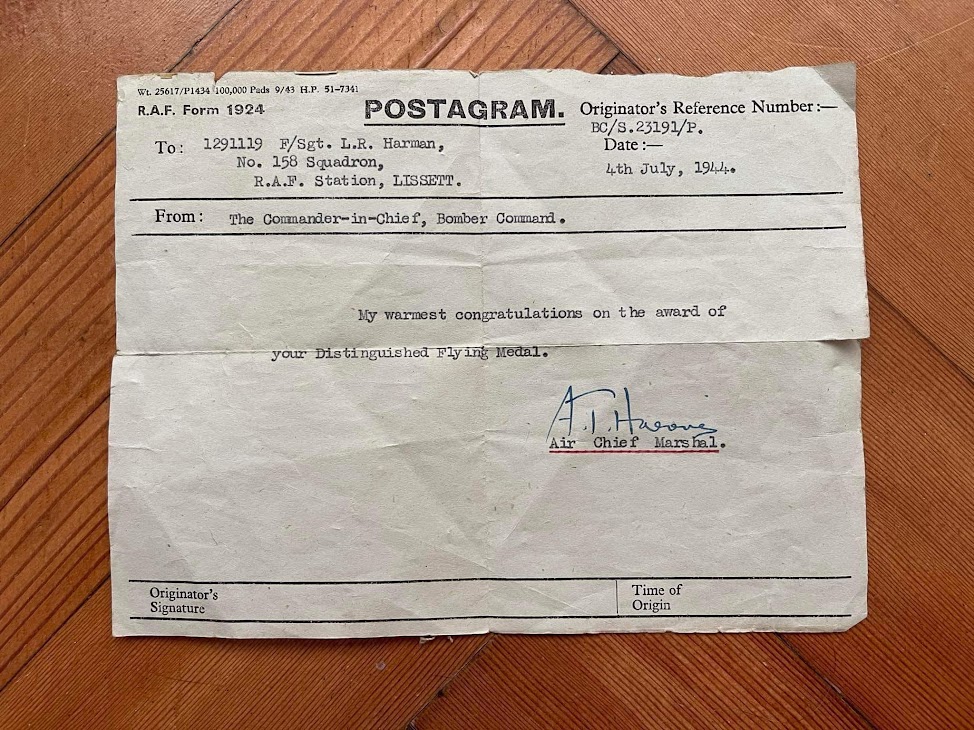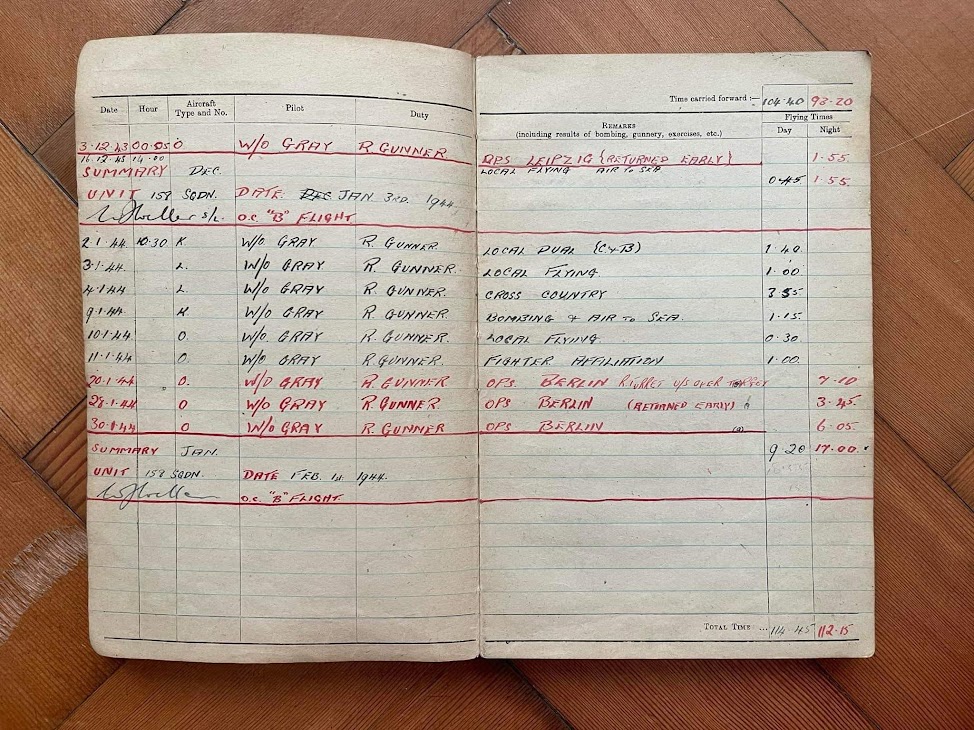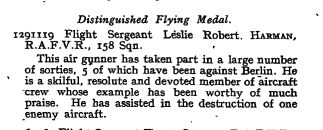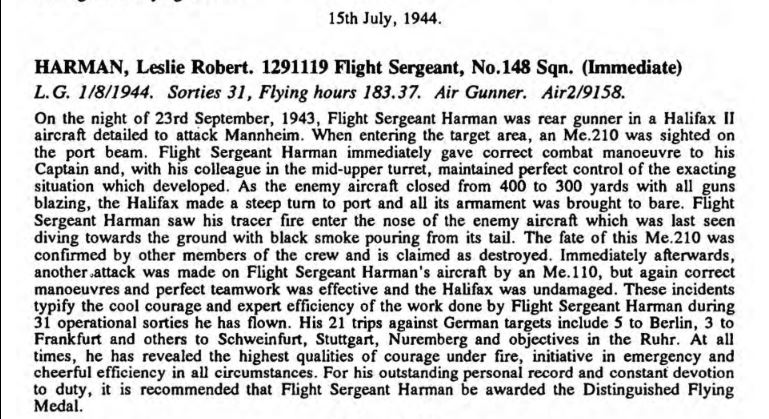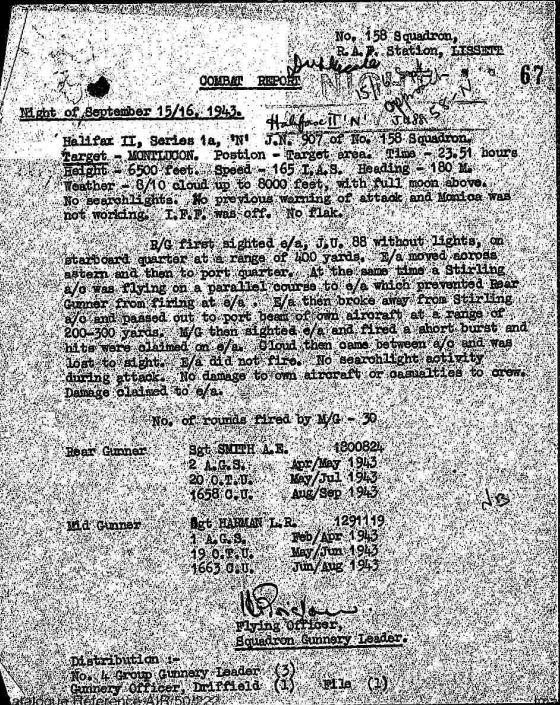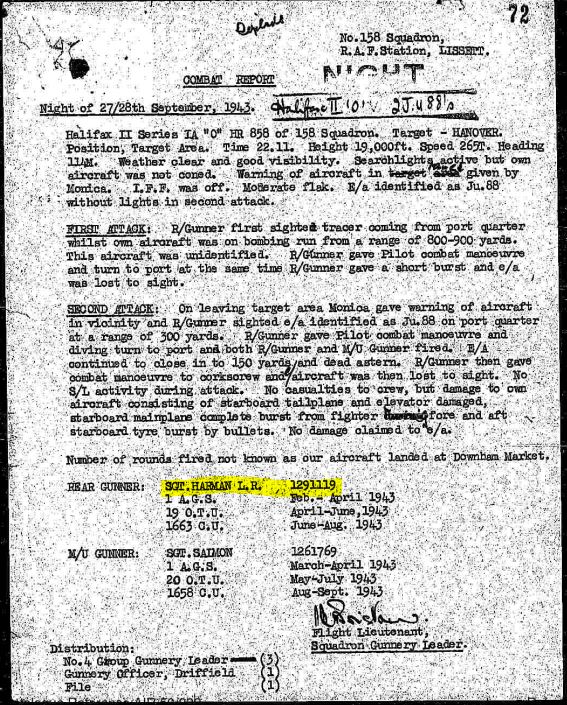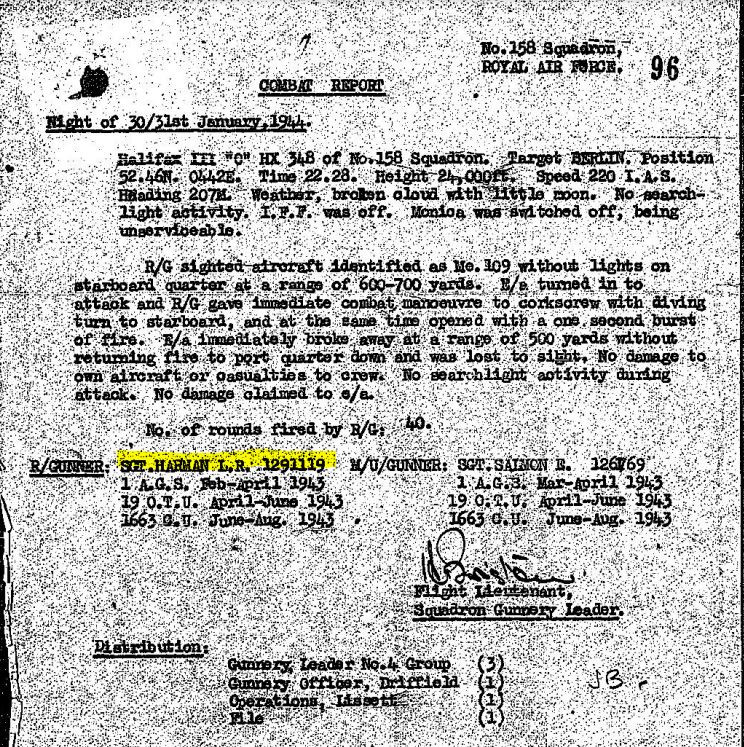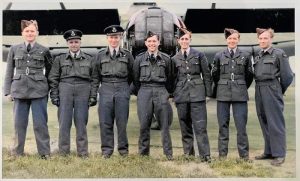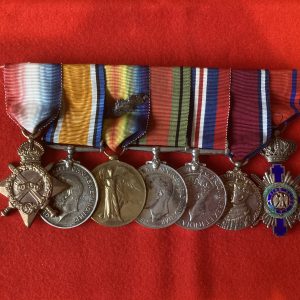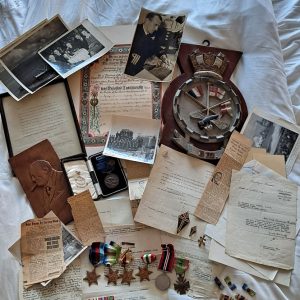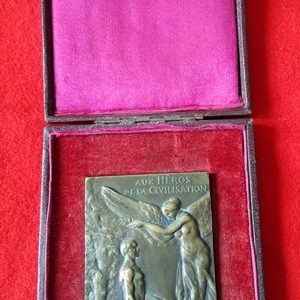Description
The 158 Squadron, Bomber Command Distinguished Flying Medal group of 1291119 Flt Sgt Leslie Robert Harman DFM, with a well annotated Log Book, congratulatory Postagram signed by Air Chief Marshal Arthur “Bomber” Harris, with photograph and other ephemera.
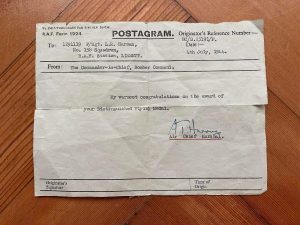
DFM citation as announced in the London Gazette 1st August 1944
Distinguished Flying Medal. 1291119 Flight Sergeant Leslie Robert HARMAN, R.A.F.V.R., 158 Sqn.
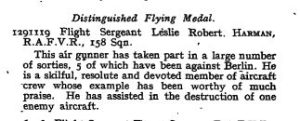 This air gunner has taken part in a large number of sorties, 5 of which have been against Berlin. He is a skilful, resolute and devoted member of aircraft crew whose example has been worthy of much praise. He has assisted in the destruction of one enemy aircraft.
This air gunner has taken part in a large number of sorties, 5 of which have been against Berlin. He is a skilful, resolute and devoted member of aircraft crew whose example has been worthy of much praise. He has assisted in the destruction of one enemy aircraft.
Initial flight experiences on Whitleyat 19 Operational Training Unit with Flight Sergeant Gray who he was to fly with on 158 Squadron. He then converts to the Halifax at 1663 conversion unit. Qualified as an air gunner at No 1 Air gunnery School, Pembrey 24,4,43. Posted to 158 Squadron 5.9.43 where he completed a full tour.
He claimed a damaged JU88 over the target on his first operation, an Me 210 destroyed on his second sortie but they were badly damaged by a JU88 on the third and the aircraft crashed on landing.
medals – Distinguished Flying Medal (1291119 F/SGT. L.R. Harman. R.A.F.V.R.), 1939/45 Star, Air Crew Europe (France & Germany bar), Defence Medal, War Medal. With Original congratulatory Postagram from “Bomber” Harris, RAF Service book, Sergeants Mess RAF Lisset book, congratulatory letter from his employer.
The following are Ops Reports and Combat Report in which Harman flew. A selection of his personal annotations in his Log Book have been added to the respective operations and have been highlighted in red italics.
15/16 September 1943
Log Book annotation – Damaged JU88 over target.
Montluçon: 369 aircraft of Nos 3, 4, 6 and No 8 Groups – 209 Halifaxes, 120 Stirlings, 40 Lancasters. 5 American B-17s also took part. 2 Halifaxes and 1 Stirling lost. This was a moonlit raid on the Dunlop rubber factory at Montluçon in Central France. The Pathfinders marked the target accurately and the Master Bomber, Wing Commander DFEC Deane, brought the Main Force in well to carry out some accurate bombing. Every building in the factory was hit and a large fire was started.”
Aircraft JN907 “N” on the night of 15/16 Sep 43. Bomb Load 2 x 1000lb. HE, 3,0601b. I.Bs. Target attacked from 6,500ft. at 23.51 hrs. heading 180M. IAS 165. 9/10 cloud at 6,000ft., visibility good. Target-identified by markers. All bombs down. Bombed on main centre of green Target was outlined by markers and two large explosions seen. immediately after bombing. to cloud layer over target. T.I.S. Incendiaries seen burning in target area,
Results were indistinct owing Sighted a/c believed Ju88. Crossed from starboard to port over target at time of bombing.
and turned on parallel course with Stirling on port-beam at 2-300 yards. Mid-upper gunner fired one burst and fighter disappeared into cloud. Aircraft landed Swanton Morley.
Combat report. Night of September 15/16, 1943.
Halifax ‘N VJ488, Halifax II, Series 1a, NJ.N 907 of No158 Squadron Target MONTLUCON. Position-Target area. Time 23.51 hours Height 6500 feet. Speed 165 1,4.3. Heading Weather, 180 M. 8/10 cloud up to 8000 feet, with full moon above. No searchlights. No previous warning of attack and Mondoa was not worlding, I.F.F. was off. No flak. B/G first sighted e/a, JU. 88 without lights, an starboard quarter at a range of 400 yards. E/a moved across a stem and then to port quarter, At the same time a Stirling a/o was flying on a parallel course to o/a which prevented Rear Gunner from firing at o/a E/a then broke away from Stirling a/o and passed out to port beam of own aircraft at a range of 200-300 yards, M/G then sighted e/a and fired a short burst and hits were claimed on o/a loud then came between e/o and was lost to sight. E/a aid not fire. No searchlight activity during attack. No damage to own aircraft or casualties to crew. Damage claimed to e/a. No. of rounds fired by M/G – 30.
23/24th September 1943 – Mannheim:
Log Book annotation – ME 210 Destroyed.
628 Aircraft – 312 Lancasters, 193 Halifaxes, 115 Stirlings, 8 Mosquitos. 5 B- 17s also took part. The Pathfinder Plan worked well and concentrated Bombing fell on the intended area, although later stages of the Raid crept back across the Northern edge of Ludwigshafen and out into the Open Country.
32 Aircraft – 18 Lancasters, 7 Halifaxes, 7 Wellingtons – lost, 5.1% of the Force.
21 Lancasters & 8 Mosquitos of No.8 Group carried out a Diversionary Raid on Darmstadt without Loss. The Diversionary purpose of this Raid was not achieved because Darmstadt was too close to Mannheim and the German Night Fighters could see the Main Attack only 20-miles away quite clearly. The small Force of Bombers caused much damage in this University Town which had little Industry and which had not been seriously Bombed before.
23/24 Sept Aircraft HR858
Bomb Load 2 x 1000 lb. MC TD025, 600 x 41b., 30 x 41b. I type, 48 x 30lb. I.B.B. Target attacked from 18,000ft. at 22.06 hrs heading 146m. Clear over target. Bombed on green markers and concentration of fires. All route markers seen. Bombed on 3 greens which were seen to cascade on run in. Fires getting good hold especially in centre of concentration. Very good concentration and attack appeared successful. Saw glow of fires for 30 mins after leaving target until view obscured by cloud.
27/28th Sept Aircraft HR858 Hannover. Log Book annotation – Very badly damaged by JU88 over target. Crashed at Downham Market. Bomb Load 1 x 10001h. CTD .025, 1 x 1000lb. GP 57B Pistol 600 x 41b., 48 x 301b., 30 x 41b. X type I.B.s. Weather good over target. Bombed from 18,000ft. at 22.1 hrs heading 114M after identifying by T.I.s. Greens seen at time of bombing but not actually in bomb sight owing to evasive action taken when a/c attacked at point of bombing by e/a. Good raid with well concentrated fires. One tyre burst on landing at DOWNHAM MARKET and a/c swung Aircraft otherwise undamaged and crew unhurt.
Combat Report. Night of 27/28th September, 1943. Halifax II Series TA “O” HR 858 of 158 Squadron. Target HANOVER Position, Target Area. Time 22.11. Height 19,000ft. Speed 265T. Heading 11M Weather clear and good visibility. Searchlights active but own MKE aircraft was not cone d. Warning of aircraft in target given by Monica. I. F.F. was off. Moderate flak. E/a identified as Ju.88 without lights in second attack..
SGT. HARMAN L.R. 1 A.G.S. 19 0.T.U. 1663 0.U. FIRST ATTACK: R/Gunner first sighted tracer coming from port quarter. whilst own aircraft was on bombing run from a range of 800-900 yards. This aircraft was unidentified. R/Gunner gave Pilot combat manoeuvre and turn to port at the same time R/Gunner gave a short burst and e/a was lost to sight.
SGT. SAIMON 1 A.G.S. 20 0.T.U. 1658 0.U. SECOND ATTACK: On leaving target area Monioa gave warning of aircraft in vicinity and R/Gunner sighted e/a identified as Ju.88 on port quarter at a range of 300 yards. R/Gunner gave Pilot combat manoeuvre and diving turn to port and both R/Gunner and M/U Gunner fired. E/A continued to close in to 150 yards and dead astern. R/Gunner then gave combat manoeuvre to corkscrew and aircraft was then lost to sight. No S/L activity during attack. No casualties to crew, but damage to own aircraft consisting of starboard tailplane and elevator damaged, at starboard mainplane complete burst from fighter fore and aft starboard tyre burst by bullets. No damage claimed to e/a.
Number of rounds fired not known as our aircraft landed at Downham Market
Book Extract.
Sergeant Les Harman, the rear gunner in ‘O-Orange’, describes what happened next:
After we had bombed the target we were again attacked by a Ju 88, which might well have been the same fighter that had attacked us earlier. This time only one of my four Brownings would fire, and that soon broke down after firing only a few rounds. The skip-per, meanwhile, began to throw the aircraft all the sky in a desperate bid to shake off the fighter. At the same time I continued to give a running commentary on the direction of the fighter’s attacks whilst as the same time frantically trying to un-jam my guns.
over
“The skipper did a superb job and we man-aged to avoid most of the cannon fire that was directed at us. Nevertheless we were hit by two particularly accurate bursts of fire which left the starboard wing, one engine and landing gear badly damaged. Despite the damage we finally lost the fighter and were able to return to England. We put down at Downham Market ending up at the side of the runway on the grass.
3/4 October 43 Aircraft JN907 Kassel. Bomb Load 1 x 1000lb. 10 T.025, 1x 1000lb. CP 57B Pistol 600 x 410., 48 x 50lb., 30 x 41b. X type I.B.. Bombed at 2130 hrs from 16,500ft. he saing 1475. No cloudd but much smoke. Bombed midway between two bunches of green T.1.5. Good fires burning. A 2200 hrs. approx. an enormous red explosion seen in target area. The aircraft was hit by a 200 bomb from above and damaged the rear starboard elevator.
Aircraft JN907 4/5th October Frankfurt. Log Book annotation – Plenty of searchlight. Didn’t like it a bit. Saw one of our kites in flames. No parachutes seen. Bomb. Load 1x. 1000 1 500lbs, 24 x 30lb. Bombed from 17000 on red TI Incendiary fires and considerable damage seen many aircraft seen being shot down.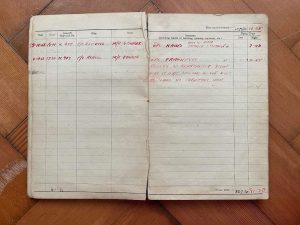
Night of the 3/4 November 1943 Aircraft JN 907 Dusseldorf. Bomb Load 1 x 1000lb. CP.37 Pistol, 1x 10001b. P.37D Pistol, 24 x 301b., 840 x 4lb., 60 x 41b, I type I.B.. Target attacked from 19,000ft. eta 1947 hrs. heading-070. IAS 165. Clear with good visibility. Identified target by 3 green 1. 1.s and 1 red T.1. green. Owing to port engine trouble bombs were dropped about 4/5 miles short of target! Small fires seen starting. Port outer engine out, leak from C.S.U.
Night of the 22/11/43 Aircraft LW314 Berlin. Log Book annotation – Not bad for a big target. Bomb Load 1 x 2000lb. Nose. Inst., 32 x 301b., 720 x Wb., 90 x 41b. x type I.Bs. 10/10 cloud to 15,000ft. Saw no -route-markers but saw Wanganui flare when about 12-miles from T/A Bombed Wanganui which burst at 2012 from 19,000ft. at 2013 hrs heading 060. IAS 160. Good concentration of flares but impossible to see results of bombing. Captain thought big yellow T. 1.s too bright and too helpful to fighters, Bomb Load 1 x 20001b
Night of the 3.12.43 Leipzig, returned early
Night of the 20/21 January 1944 aircraft “0” Berlin. Bombload 2 x 1000lb. JC TD 025, 2×500 clusters 360 x 41b., 90 x 4b. I type, 24 x 301b. I.B 10/10ths cloud. Identified target by markers and bombed at 1945-hrs-from 20,000ft. heading 150m. IAS 180. One 8×30 hung up. Best concentration of markers ever seen and of other aircraft bombing, rear turret was US over the target.
Night of 28/1/1944 Aircraft HX 348 Berlin. Bomb load 2 x 1000lbs MC 025, 2x 500lb. Cluster 41lb 24 x 301b., 390 x 41b., 60 x 4b. x type L.B. Engines became overheated and aircraft was unable to climb above 15,500ft. Some icing experienced. Mission abandoned 30 miles from coast and all bombs jettisoned at 551N.. 0735E at 0216 hrs. from 15,000ft.all Bomb Load jettisoned.
Night of 30/1/44 HX348 Berlin. Bomb Load 1 x 10001b, GP 37 Pistol, 1 x 10001b, 370 Pistol, 2 x 500lb. clusters 41b., 24 x 30lb., 390 x 4lb. 60 x 4ib. x type 1.B. 10/10.cloud layer at 10,000.ft. Horizontal visibility good. Bombed centre of flares, red with green stars, at 2036 hrs. from 21,000ft. heading 187M-TAS 175. Saw faint glow of fire and column of brownish “Smoke rising about cloud layer and white fighter flares. R/G fired at BF. 109 at 2228 hrs. 5246N.04421. No return fire. No claim made of damage to e/a.
Night of 15/2/44 HX356 Berlin. Log Book annotation – attacked by BF 109 over Zyder Zee. Bombed centre of sky markers, red with green stars, at… 2133 hrs. from 22,000ft. heading 167 IAS 170. 10/10 cloud-8-10,000ft, and hazy, directly under sky markers. as far as could be observed. Saw glow of fires on cloud Results appeared satisfactory
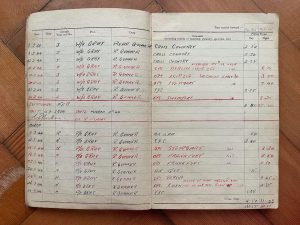 Night of the 19/2/44 HX356 Leipzig. This aircraft had to abandon mission owing to ASI and TR 1196 becoming u/s. Furthest point reached 54708, and all bombs were jettisoned at 54201. 05159 at 0203 hrs. from 2,000ft.
Night of the 19/2/44 HX356 Leipzig. This aircraft had to abandon mission owing to ASI and TR 1196 becoming u/s. Furthest point reached 54708, and all bombs were jettisoned at 54201. 05159 at 0203 hrs. from 2,000ft.
Night of the 20/02/44 HX356 Stuttgart. Bombed centre of green target indicators at 0409 Hrs from 22,000ft. heading 0171 IAS 190. 5/10 cloud over target. Saw Wanganui and Peramatta going down as aircraft-arrived Some ground detail was faintly seen on leaving target and very good and concentrated fires: aircraft was nearly 10 mins. early and hung about before bombing. Opposition in T/A was negligible though many S/Ls In Manheim direction. No fighter activity observed.
Night of the 24/02/44 HX356 Schweinfurt. Clear over target. Pathfinder had target clearly marked and
bombed at 2319 hrs, from 22,000ft. beading 050M. IAS 190. 30-x-41b. IBs hung up Markers were very well concentrated and the only two sky markers seen were not needed. Fires were going well, especially in the centre where the built-up areas were outlines. A few bombs seemed to be Falling short
Night of the 15 March 1944 HX340 Stuttgart. 8/10 cloud. Red T. I. seen burning on the ground and bombed at 2332 hrs. from 20,000ft. heading 035M. IAS 162. Markers and flares were widely placed and glow of fires visible
around a wide area. There was moderate light flak. Landed Thorney Island Two good concentrations of fires seen, one in vicinity of T. I. and another to the south.
Night of the 18/03/44 HX356 Frankfurt. No cloud over target but some snow. Target could be seen when a/c was right over it and centre of 6 red T.Is burning on the ground was bombed at 2207 hrs. from 21,000ft heading 177. IAS 170. Red T.I.s were well concentrated and there were several very good fires well concentrated round the markers.
Night 22/03/44 LV790 Frankfurt. 5/10 cloud over target. Saw sky markers red dropping yellow and then red T.I. and bombed centre of glow of greens and several red P. I. at 2153 hrs. from 21,000ft. beading 175M. IAS 170. Ground markers seemed fairly well concentrated and fires were already alight. Mid/U/Turret holed in perspex by H/Flak in target area.
Night of the 24/25/03/44 HX340 Berlin. 6/10 cloud, tops 10-12,000ft., poor visibility. Bombed centre of 4 Wanganui flares at 2230 hrs, from 21,000ft. heading 215K. IAS 170. Several red and green T.I. and Tanganui flares seen and a few scattered fires
Night of the 26/3/44 HX340 Essen, plenty of enemy aircraft . Log Book annotation – Plenty of huns around. Saw one of our kites blow up. 10/10 cloud with tops approx. 15,000ft. over target. Bombed estimated centre of glow of reds at 2204 hrs. from 22,000ft. heading 157m. IAS 160. There was much black smoke and numerous vapour trails all converging on position where red T.I. were falling. Numerous bombers were seen. Wanganui flares were seen to port over target.
Night of 30.03.44 Nurenberg (lots of aircraft lost) Cyril Barton a Halifax pilot of 578 Sqn was awarde the VC this night. 795 RAF bombers: 572 Lancaster, 214 Halifax, 9 Mosquitos. Log Book annotation – Huns everywhere, saw plenty of our kites going down.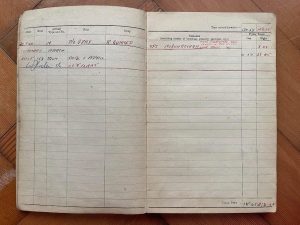
“The Nuremberg Raid”: The attackers suffered heavy losses: 95 bombers were shot down. In Nuremberg the attack was classified as “moderately severe”, further damage in the eastern neighboring towns (Röthenbach an der Pegnitz, Behringersdorf, Lauf an der Pegnitz).in Nuremberg: 74 casualties and 122 injured; 130 destroyed, 879 moderately damaged buildings and 2505 with minor damage
For this attack on Nuremberg Bomber Command detailed a total of 795 aircraft were dispatched – 572 Lancasters, 214 Halifaxes and 9 Mosquitos.
This would normally have been the moon stand-down period for the Main Force but a raid to the distant target of Nuremberg was planned on the basis of an early forecast that there would be protective high cloud on the outward route, when the moon would be up, but that the target area would be clear for ground-marked bombing. A Meteorological Flight Mosquito carried out a reconnaissance and reported that the protective cloud was unlikely to be present and that there could be cloud over the target, but the raid was surprisingly not cancelled.
The German controller ignored all the diversions and assembled his fighters at 2 radio beacons which happened to be astride the route to Nuremberg. The first fighters appeared just before the bombers reached the Belgian border and a fierce battle in the moonlight lasted for the next hour. 82 bombers were lost on the outward route and near the target. The action was much reduced on the return flight, when most of the German fighters had to land to refuel, but 95 bombers were lost in all – 64 Lancasters and 31 Halifaxes, 11.9 per cent of the force dispatched. It was the biggest Bomber Command loss of the war. A further 10 aircraft were written off with battle damage or crashed on return.
Most of the returning crews reported that they had bombed Nuremberg but subsequent research showed that approximately 120 aircraft had bombed Schweinfurt, 50 miles north-west of Nuremberg. This mistake was a result of badly forecast winds causing navigational difficulties. 2 Pathfinder aircraft dropped markers at Schweinfurt. Much of the bombing in the Schweinfurt area fell outside the town and only 2 people were killed in that area. The main raid at Nuremberg was a failure. The city was covered by thick cloud and a fierce cross-wind which developed on the final approach to the target caused many of the Pathfinder aircraft to mark too far to the east. A 10-mile-long creepback also developed into the countryside north of Nuremberg. Both Pathfinders and Main Force aircraft were under heavy fighter attack throughout the raid. Little damage was caused in Nuremberg.
Night of 10/04/44 LV918 Tergnier. No cloud but some ground haze. Red T. L seen going down. at 2350. Bombed centre of two reds (which cascaded at 2350 hrs.) at 2354 hrs. from 9,500ft heading 070M. TAS 175. A/B SAW bomb bursts across the T.I.S.
Night of the 18/4/44 LV918 Tergnier. Clear over target. but some haze. Salvos of red and seen T.I.s seen to go down at 2330 and centre of salvos bombed at 2335 hrs, from 13,500ft heading 046M. TAS 180. Salvos were very well placed, one going down on top of the other. At least one stick of bombs was seen to cross Target indicators.
Night of the 20/04/44 LV918 Ottignier. No cloud but some haze. Bombed southern target markers as instructed…….. by M/C at 2321 hrs. from 15,000ft. heading 070M. IAS 160. Bombs seemed to be bursting near the target. Aircraft bombed 3 minutes late as a second circuit had to be made. 1123 not very satisfactory.
Night of the 22/04/44 LV918 Dusseldorf, Coned by Searchlights, flak etc. Log Book annotation – Coned and damaged by Flak, had to abandon A/C. Weather was clear apart from intense vapour trails, Reds seen to go down at 0116 hrs. and red T.I. and fires were bombed at 0126 hrs from 19,000ft. heading 007 IAS 185. A/B saw river with intense fires burning along the side, markers seemed well concentrated with the main bombing well on them. Some incendiaries were short but still on the town.
Night of the 24/04/44 LV918 Karlsruhe. Clear over target. Bombed centre of salvos of red and green T.I.s from 21,000ft. at 0042 hrs, heading 110M. TAS-165. Aircraft was early over target owing to change of winds. There was a good concentration of fires
Night of the 26/04/44 LV918 Villeneuve. Clear, but some haze, Red and yellow-Target indicators seen and target was also identified visually. Bombs dropped on red T. I at 0045 hrs. from 10,300ft, heading 034M. TAS 190. Master Bomber was not heard, Target could be seen clearly and T.I.S appeared to be a little short of aiming point.
Night of the 8/05/44 LV918 Marsalines. Weather clear, saw red Target indicators cascading at 0252 hrs. and
bombed centre of 5 tightly placed T.I.s at 0257 hrs. from 3,500ft, heading 187 TAS 170. On run in air bomber saw compact lane of T.I.s and then another T.I. fell right in the middle of it: Other bombs were falling across the T.Is
Night of 27/28/04/44 HX340 Bourg leopold. There was no cloud but some ground haze. Attack was seen opening with red target indicators at 0157 hrs. centre of one-red and one green 1.I. – which were both receiving attention at 02134 hrs. from 10,000ft. Heading 087M. IAS 185. & white, red and green TIS were seen but as it was impossible to distinguish the Master Bomber’s instructions the aircraft bombed the position which was receiving the most attention
Night of the 1st June 44 HX340. 10/10 cloud. Sky markers with green-stars-seen-first bursting at 0109 hrs. Bombed Wanganui flare (which burst at 0114 hrs.) at 0117 hrs. from 14,000feet. Heading 150M. IAS 175. Two Wanganui flares were seen, but went out as aircraft reached them and then a 3rd dropped about half a mile to starboard. we went round again and bombed a fourth flare seen about the position of the first two.
Night of the 2 June 44 HX340 Trappes. Log Book annotation – Plenty of light and accurate Flak. Weather clear. T.I.s of all colours seen and M/B Bombed yellow T.I. as instructed at 0052 bombed from 10,000ft. heading 223. IAS 180, White and yellow T.I.s were together and red T.I. slightly to south. Explosion was seen at 0056 hrs,
Night of the 5 June 1944 Maisy. Log Book annotation – saw invasion fleet. Thin layer of cloud at 10,000ft. and also at 13-14,000ft Identified target by red and green T.I.s and bombed centre of 3 reds and 3 greens at 0322 hrs. from 12,000ft. heading 215M. IAS 175. There was a good concentration of bursts around the Tis.
6/7th June 1944 Chateaux Dunn. Log Book annotation – Straffed enemy convoy K.O. 3 lorries. Bombed on white T. I. as directed by Master Bomber, at 0209 hrs. from 11,000ft. heading 178. Good attack. 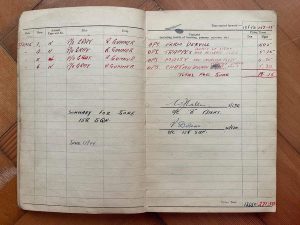

Another 158 Sqn aircraft hit by rogue bomb from above in the bomber stream.
Lissett Airfield (RAF Lissett) 280 km North of London. The Airfield was built during 1942 as a Class A Bomber Airfield for Bomber Command’s No.4 Group, featuring 36 Pan-type Dispersals and 2-T2 Hangars. Facilities arranged around the Airfield were capable of handling 1800 personnel. The 1st Unit at the Airfield was 158 Squadron, originally a Halifax Bomber Unit from RAF Rufforth. 158 Squadron participated in Main Force Operations during 1943 and at the end of that year, its C-Flight was used to form a new Squadron to be Based at RAF Leconfield. The Squadron continued to Operate until the end of the War and participated in 250 Raids during which it Lost over 144 – Halifaxes from Crashes or Enemy fire. Their Final Operation was Flown 2-Weeks before the end of the War. 158 Squadron was transferred to Transport Command on 7th May 1945 (VE Day) and began to convert to Stirling Mk V Transports. When the Squadron was ready for their new Role, they moved to RAF Stradishall. Lissett was then put on Care & Maintenance Status with only a small Caretaker Staff remaining. Care & Maintenance ended by the end of the year and the Airfield was abandoned.
PAYPAL is NOT available for this item. Overseas buyers must contact us to agree shipping prior to order. Email ttandm4h@outlook.com for details or call 07765 595662 to arrange.
Card Payment on Checkout, Bank Transfer (Account name: ttandm4h, Sort Code 30-94-41, Account number 48469068).
Part Exchange welcome.




